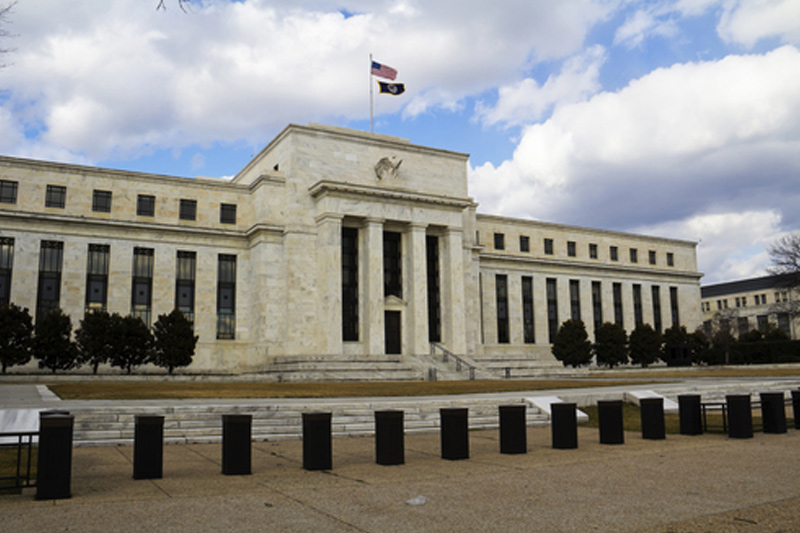(Bloomberg) -- Sign up for the New Economy Daily newsletter, follow us @economics and subscribe to our podcast.
Investors gauging the likely size of the Federal Reserve’s interest-rate hike in March and plans for shrinking a balance sheet now at a record $8.9 trillion will get fresh clues on Wednesday.
That’s when the Fed publishes minutes of last month’s policy meeting, where Chair Jerome Powell told reporters the U.S. central bank is on track to raise rates for the first time since 2018 and officials also shared general principles for normalizing their balance sheet. The minutes will be released at 2 p.m. in Washington.
Officials are pivoting toward fighting the hottest inflation in 40 years and removing the massive support they deployed to protect the economy from Covid-19. That’s prompted speculation that they may act more aggressively to get price pressures back under control, with some betting on a half-point move, which would be the first increase of that scale since 2000.
“If there was some discussion of 50 basis points, we may get a very oblique reference to it in the minutes,” said Andrew Hollenhorst, chief U.S. economist at Citigroup Inc).. “You might get a statement of the pros and the cons. That keeps it alive for the March meeting. The minutes could sound a bit hawkish if there was some discussion.”
While the minutes could show that a 25 basis-point move was viewed in January as the most likely course, they could hint at conditions under which the Fed might consider something larger, he said.
What Bloomberg Economics Says...
“Whether the FOMC committee has an appetite for a 50-basis point hike in March -- as markets now have priced in -- will depend on members’ and Fed staff’s assessment of the urgency of the inflation outlook, and whether the Fed is “behind the curve.” The January FOMC minutes may provide clues to that, and explain why Fed Chair Jerome Powell gave such a hawkish post-meeting presser.”
-- Anna Wong, Yelena Shulyatyeva, Andrew Husby and Eliza Winger (economists)
-- To read more, click here
Inflationary pressures have accelerated since officials met last month, with consumer prices rising 7.5% in January from a year ago, while both U.S. employment and wages have surged. Policy makers will see another inflation and jobs report before their March meeting.
With the FOMC estimating the long-run neutral level of their benchmark federal funds rate at around 2.5%, the minutes could give a sense of the urgency the committee felt in getting it up there -- from near zero currently -- even before the latest inflation news.
“Inflation is the number-one concern and number-one priority,” said Aneta Markowska, chief financial economist at Jefferies LLC. “Everybody knows that the Fed is behind. The question is how quickly do they intend to catch up to an appropriate policy stance.”
Markets are now pricing in six or seven quarter-point moves by the end of 2022, including the possibility of a 50-basis point hike in March. The FOMC forecast just three quarter-point hikes in its last projections in December. Powell, in his post-meeting January press conference, declined to rule out a 50-basis point hike.
Balance Sheet
With its other monetary policy tool, the Fed is currently scheduled to end its asset-purchase program in early March, ahead of the policy meeting. Powell said discussions over shrinking the balance sheet -- which some investors call quantitative tightening -- will be held at upcoming gatherings.
“We need to hear details from the Fed on how they are going to do QT and we need to hear them soon,” said Mark Holman, a partner at TwentyFour Asset Management, a London-based investment firm that specializes in fixed-income securities.
“The case for the Fed to do something quickly is growing day by day, especially given how disappointing the recent inflation report was,” said Holman, who thinks the Fed should sell some of its long-term Treasuries to help prevent the yield curve from inverting.
In a January statement, the Fed said it expects the process of balance-sheet reduction will commence after it has begun raising rates. It also spelled out that it planned to “significantly” shrink the balance sheet over time, while in the longer run holding mainly Treasury securities, implying a desire to shed most of the $2.7 trillion of mortgage-backed securities that it also currently owns.
Powell said no decision was taken at the January meeting on the pace of the runoff or when it would start.
At least two officials -- St. Louis Fed President James Bullard and Kansas City Fed chief Esther George -- have since raised the possibility of selling assets in the future. Officials haven’t disclosed details of how much runoff would be targeted in the initial months or what the size of the balance sheet should be longer term.
Last time they shrank the balance sheet, official set caps to govern how much of their maturing securities would be allowed to run off every month and how much would be reinvested to ensure the process would be gradual.
“I would love to see some actual specifics on cap sizes and methodology. And balance between” mortgage-backed securities and Treasuries, said Blake Gwinn, RBC Capital Markets strategist.
©2022 Bloomberg L.P.
